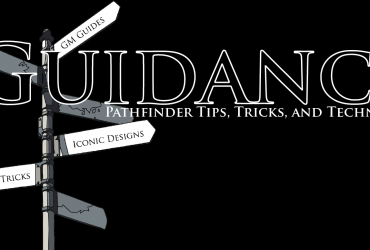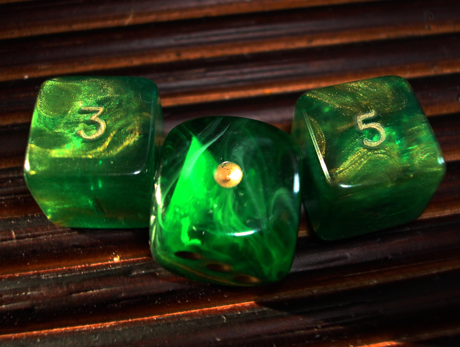Welcome to Guidance, Private Sanctuary’s source for tips and techniques for the Pathfinder Roleplaying Game, written by Everyman Gamer Alexander Augunas. Today, we’re going to be talking about terrain in encounter design.
Irony is a horrible, horrible thing.
Back when I ran the GM’s Guide to Challenging Encounters, the #1 topic that was ALWAYS requested of me was terrain. “How do I incorporate terrain into my encounter design?” “What are some good ways to use terrain in my encounter design?” “Tell me how to use terrain in my encounter design.” It was (and still is) the most commonly requested topic that I get.
I never design encounters with terrain in mind. Ever.
You have no idea how hard it was to sit down and try to give people tips and advice on a topic for something I personally don’t even consider myself. That isn’t to say that I ignore Pathfinder’s terrain rules or run all of my encounters on blank, featureless spaces. But what I am saying is that when I sit down to design an encounter, the last thing on my mind is, “And I’ll place this monster in a swamp because it’ll make the encounter harder!” If you want to know why I think terrain is the absolute least important part of encounter design, read on. If I’ve gravely offended you with my blatant disregard for the forces of nature (because you’re a druid) I understand if you feel the need to close this webpage. I forgive you. (No I don’t.)
Terrain’s Effects on Encounter Design
Now, just because I blatantly disregard terrain when I build my encounters doesn’t mean that terrain has no impact on encounter design at all! According to the the Core Rulebook, placing a monster in a combat that grants it an advantage increases the encounter’s CR by +1 while placing a monster in an environment that grants it a disadvantage reduces the encounter’s CR by –1. This rule is pretty simple, pretty straightforward, and pretty horrible in my opinion.
Why This Rule Is Horrible
I 100% advise against using the above rule when you’re designing combats. Why? Terrain is easy to nullify, especially at high levels. Think about it: you’re in a swamp. Swamps are difficult terrain. Your party has a Level 5 wizard. How many ways can you make the swamp irrelevant? Here’s a short list: feather step, fly, touch of the sea, levitate. None of those spells are higher than 5th level, but if your group spellcaster has access to even one of them, the fact that your swamp terrain imposes difficult terrain doesn’t matter and that encounter that you planned on being CR 7 is now only CR 6, which might not be challenging enough for your tastes. And sure, completely bypassing terrain in this manner is shortly lived (especially at low levels) but gods help you if your PCs acquire a wand of any of these spells or a magic item that provides the spell as a continuous effect. As a special shout-out, you can buy a pair of slippers of feather step for 2,000 gp. Feather step allows you to ignore ALL difficult terrain, and roughly 50% of all terrain is difficult terrain. That encounter is no longer challenging because of one easy-to-purchase magic item. In effect, the more powerful your PCs get the better chance that they can completely ignore terrain as a challenging mechanic.
How I Use Terrain In Encounter Design
- I pick the location of the combat, including the terrain. This is important because it helps me set the tone and feel for my combat: a crawl through a forgotten crypt has a different feel then a romp through a wood, and as a result I’m going to use different monsters in each location.
- I design all of my encounters. I pick the CR that my players will go up against, I plan all of the aspects of the encounter that my PCs will find challenging. Not once to I even think about terrain during this step, however.
- I design the terrain. Step Three is optional: sometimes I wing the terrain and just draw it in wherever I want. (I typically such spontaneity exclusively for outdoor encounters: in dungeons, my terrain is meticulously planned in advanced.) I keep a handy list of potential terrain effects for the type of terrain I’m using and apply them as necessary: sometimes I randomly roll to determine the weather or sometimes I allow the player to unwittingly determine the weather by making a Survival skill check to forecast the weather. Oh those poor, unfortunate players ….
- I run the combat.
- I award experience. If the terrain proved to be advantageous to the enemies, I effectively increase the encounter’s CR by +1 for the purpose of determining the XP award alone. In contrast, if the terrain proved to be a hindrance to the enemies, I decrease the encounter’s CR by –1 for the purpose of determining the XP award. If the terrain provided little to no benefit or hindrance, I leave the XP award as-is. In effect, I use the terrain rules after the fact as a reward system for particular deadly combats rather than as a tool to determine the difficulty of my combats before the fact.
And that’s all I have to say about terrain. For now. What do you think? Is terrain an integral part of your encounter design or do you treat it like I do? Do you think terrain can remain challenging at all levels of play? Do you think that terrain is worth increasing the CR of an encounter for if the players devote arcane or divine resources to negating it? Do you want me to write more about terrain? If so, what types of tips and tricks are you looking for? Leave your questions and comments below and I’ll see you next time for a (slightly) less angry article!
Alexander “Alex” Augunas has been playing roleplaying games since 2007, which isn’t nearly as long as 90% of his colleagues. Alexander is an active freelancer for the Pathfinder Roleplaying Game and is best known as the author of the Pact Magic Unbound series by Radiance House. Alex is the owner of Everyman Gaming, LLC and is often stylized as the Everyman Gamer in honor of Guidance’s original home. Alex’s favorite color is blue, his favorite Pathfinder Race/Class combination is kitsune druid, and he has personally travelled to 11 of the United State’s 13 original colonies. (He’s never been to Georgia or South Carolina, though he’s had plenty of opportunities to go.)







Leave a Reply